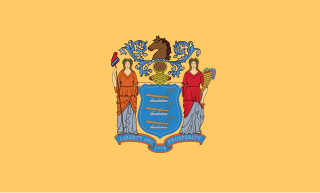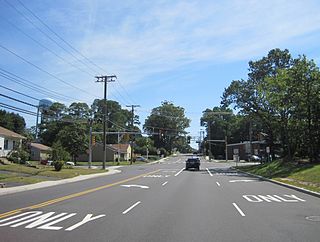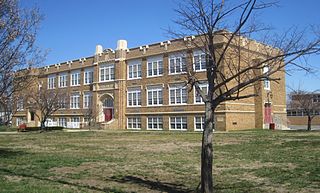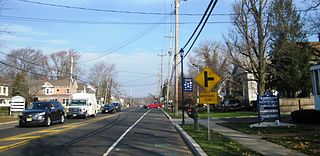The Florence and Keyport Plank Road was a partially built plank road in New Jersey.

A plank road is a road composed of wooden planks or puncheon logs. Plank roads were commonly found in the Canadian province of Ontario as well as the Northeast and Midwest of the United States in the first half of the 19th century. They were often built by turnpike companies.

New Jersey is a state in the Mid-Atlantic and Northeastern regions of the United States. It is located on a peninsula, bordered on the north and east by the state of New York, particularly along the extent of the length of New York City on its western edge; on the east, southeast, and south by the Atlantic Ocean; on the west by the Delaware River and Pennsylvania; and on the southwest by the Delaware Bay and Delaware. New Jersey is the fourth-smallest state by area but the 11th-most populous, with 9 million residents as of 2017, and the most densely populated of the 50 U.S. states; its biggest city is Newark. New Jersey lies completely within the combined statistical areas of New York City and Philadelphia. New Jersey was the second-wealthiest U.S. state by median household income as of 2017.
The Florence & Keyport Company was chartered in Monmouth County, New Jersey on March 1, 1850. [1] The Florence & Keyport Joint Companies were chartered in Monmouth County on August 17, 1853; one object of the company was “the construction of and maintenance of Roads leading to and from said depots, on which said business may be done, and also to purchase and hold the stock of such Road Companies or other corporations as will extend the business of this Company and promote the object of its organization.” [2] Intended as a toll road to run from Florence, Burlington County, on the Delaware River to a point (now Union Beach) near Keyport on Raritan Bay. The only part planked was beginning at the foot of Dock Street, Union Beach, thence up Dock to State Street (now Florence Avenue, part of County Route 39 ), thence southwest to end at Main Street, Keyport (now County Route 4. Here was as far as they got with the planked surface. It is known that the planking was proposed to continue along Clark Street to approximately Beers Street, from which it was to set off in a southwesterly direction, [3] crossing into Hazlet and Aberdeen Townships and intersecting Lloyd Road and Church Street. From there it was to follow Lloyd Road to the Monmouth County Plank Road (the present New Jersey Route 79). The segment west of Beers Street was laid out as a public road on May 13, 1859. This road return was the subject of two caveats filed against it: One from William W. Ackerson, through whose land it was to run, and one from the Township Committee as a body. As a result, on February 23, 1860, a committee of the Monmouth County Board of Chosen Freeholders voted to quash this road return as “unnecessary and injurious." Also laid out on May 13, 1859 was that portion between the present Reid's Hill Road and New Jersey Route 79; this segment was opened to the public and became known as Lloyd Road.

Monmouth County is a county located in Central New Jersey, in the United States within the New York metropolitan area, and the northernmost county along the Jersey Shore. As of the 2017 Census estimate, the county's population was 626,351, making it the state's fifth-most populous county, representing a decrease of 0.6% from the 2010 Census, when the population was enumerated at 630,380, in turn an increase of 15,079 from 615,301 at the 2000 Census. As of 2010, the county fell to the fifth-most populous county in the state, having been surpassed by Hudson County. Its county seat is Freehold Borough. The most populous place was Middletown Township, with 66,522 residents at the time of the 2010 Census, while Howell Township covered 61.21 square miles (158.5 km2), the largest total area of any municipality.

Burlington County is a county located in the U.S. state of New Jersey. The county is the second largest in New Jersey by total area behind Ocean County which has a total area of 915.40 sq mi and its county seat is Mount Holly. As of the 2017 Census Bureau estimate, the county's population was 448,596, making it the 11th-largest of the state's 21 counties, representing a 0.1% decrease from the 2010 United States Census, when the population was enumerated at 448,734, in turn an increase of 25,340 (6.0%) from the 423,394 enumerated in the 2000 Census. The most-populous place was Evesham Township, with 45,538 residents at the time of the 2010 Census, while Washington Township covered 102.71 square miles (266.0 km2), the largest total area of any municipality in Burlington County.

The Delaware River is a major river on the Atlantic coast of the United States. It drains an area of 14,119 square miles (36,570 km2) in five U.S. states: Delaware, Maryland, New Jersey, New York, Pennsylvania. Rising in two branches in New York state's Catskill Mountains, the river flows 419 miles (674 km) into Delaware Bay where its waters enter the Atlantic Ocean near Cape May in New Jersey and Cape Henlopen in Delaware. Not including Delaware Bay, the river's length including its two branches is 388 miles (624 km). The Delaware River is one of nineteen "Great Waters" recognized by the America's Great Waters Coalition.











